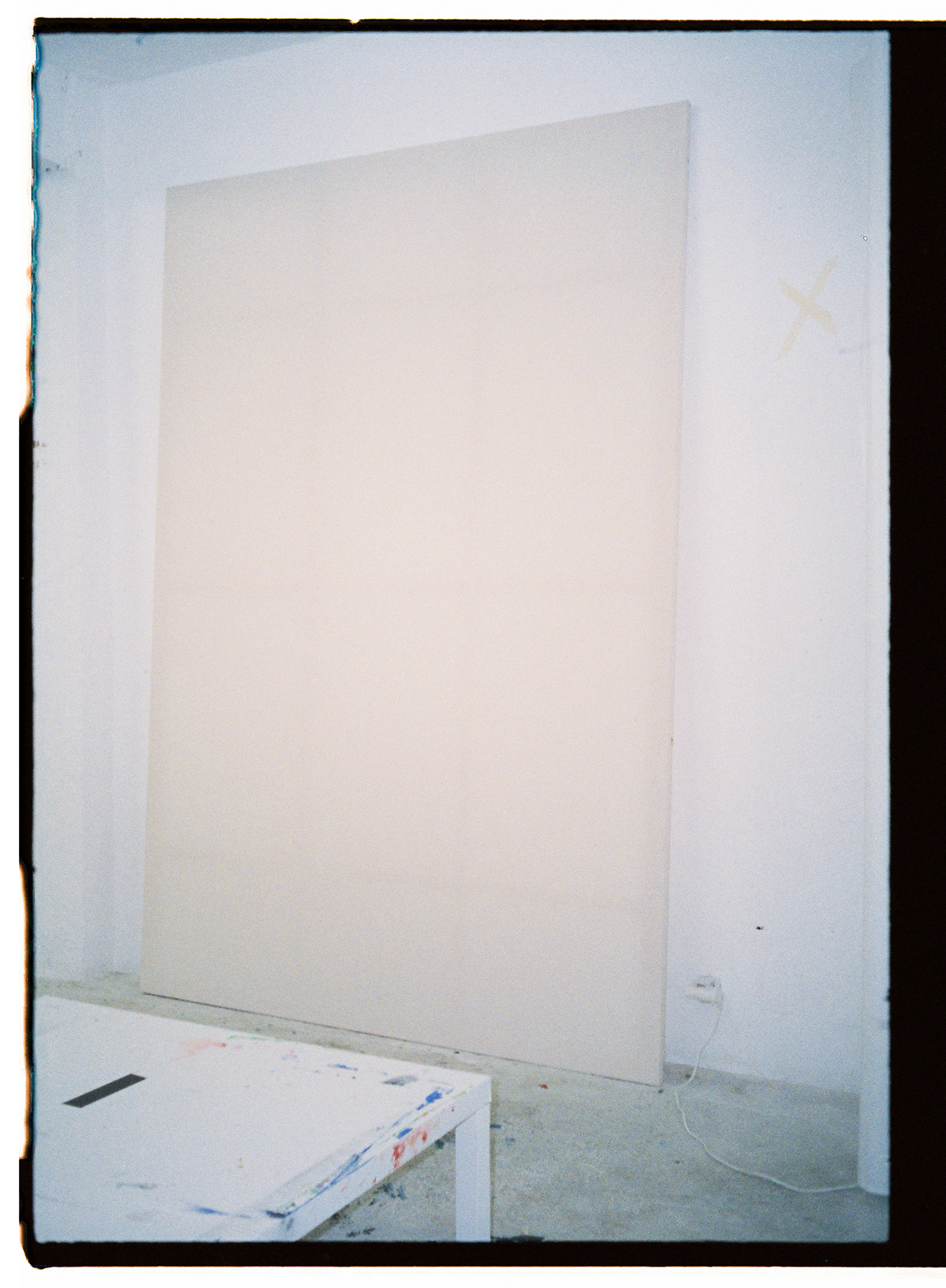Ela Fidalgo
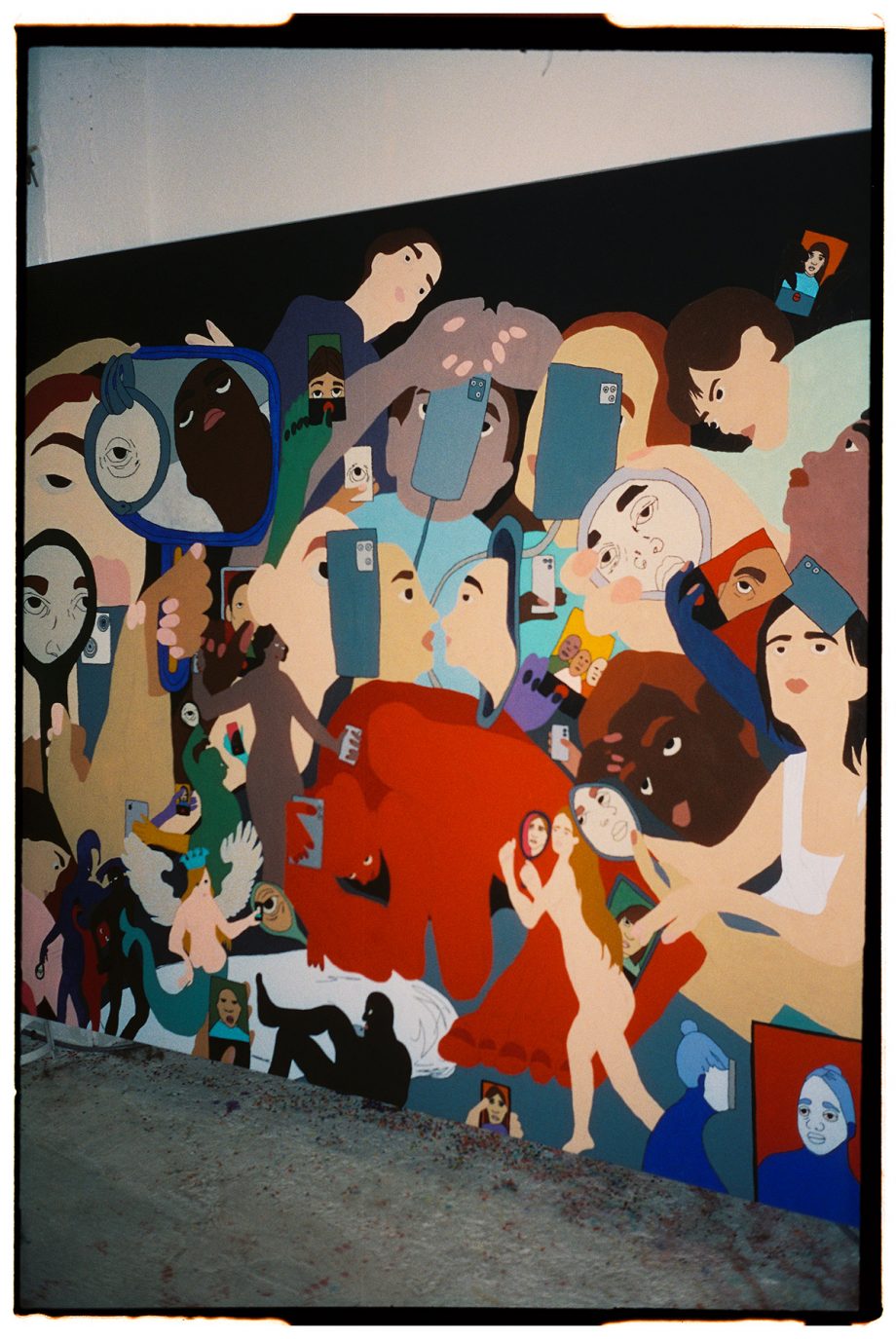
PHOTOGRAPHY BY MARGARITO DELA GUETTO WORDS BY ELA FIDALGO
There’s a piece I read a while ago by Yoko Ogawa; I stumbled upon it while reading Byung- Chul Han’s book, “No-Things,” which is a text that greatly inspires me and makes me reflect on the times we live in. It goes like this:
“The world continuously empties itself, In the end, it disappears. Everything vanishes in a progressive dissolution. Even parts of the body disappear, and, in the end, only voices without bodies float aimlessly in the air. The unnamed island of lost things and memories somewhat resembles our present. Today, the world empties itself of things and fills with information as unsettling as those disembodied voices. Digitisation dematerialises and disembodies the world.”
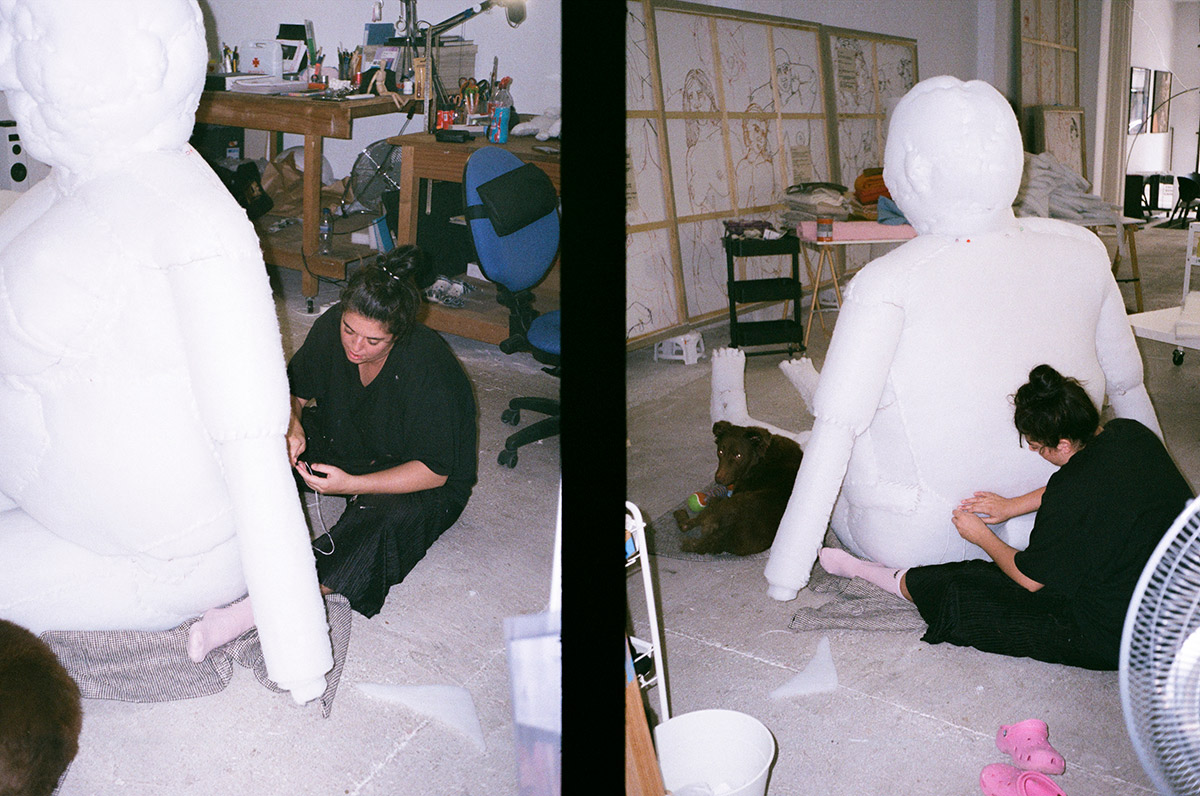
In her novel, “The Memory Police,” the Japanese writer Yoko Ogawa talks about an unnamed island. Strange events unsettle the island’s inhabitants as things inexplicably disappear and become irretrievable. Today, things constantly vanish without us realising it, and the inflation of things deceives us into believing the opposite. Unlike Yoko Ogawa’s dystopia, we don’t live in a totalitarian regime with thought police brutally stripping people of their things and memories. As information hunters, we turn blind to silent, discreet things, including the usual, the trifles, and the mundane, which don’t stimulate us but anchor us in our existence. In today’s society, which has developed a fear of pain and has no place for suffering, this is reflected both on a personal and societal level, even in politics. The truth is that we’re hooked to those filters where everything appears perfect, making us slaves to an unreal and virtual life.
I’ve always painted, or rather, drawn. I was an imaginative child with attention deficit. I used to get quite bored in class, never excelled in my studies, and as a result, my textbooks, notebooks, and exams were filled with doodles and drawings. I always wanted to take painting or drawing classes. I loved drawing fashion sketches and manga drawings; those could be the first drawings I created. My parents always enrolled me in sports, so I independently developed my creative ideas.
I quit studying scientific high school because it had nothing to do with me, and I switched schools to start artistic high school. It was there, thanks to some teachers, that I nurtured my most creative side. I had what I think was a revelation in my sculpture class, where we worked on three-dimensional art. Our teacher at the time, Alfons Sard, was a passionate instructor who made you fall head over heels for the subject and saw you coming before you did. Some teachers suggested that I study fine arts, but I was afraid of disappointing myself because I thought I didn’t have much to say or do in that field. Plus, I already had in mind that I wanted to study fashion design.
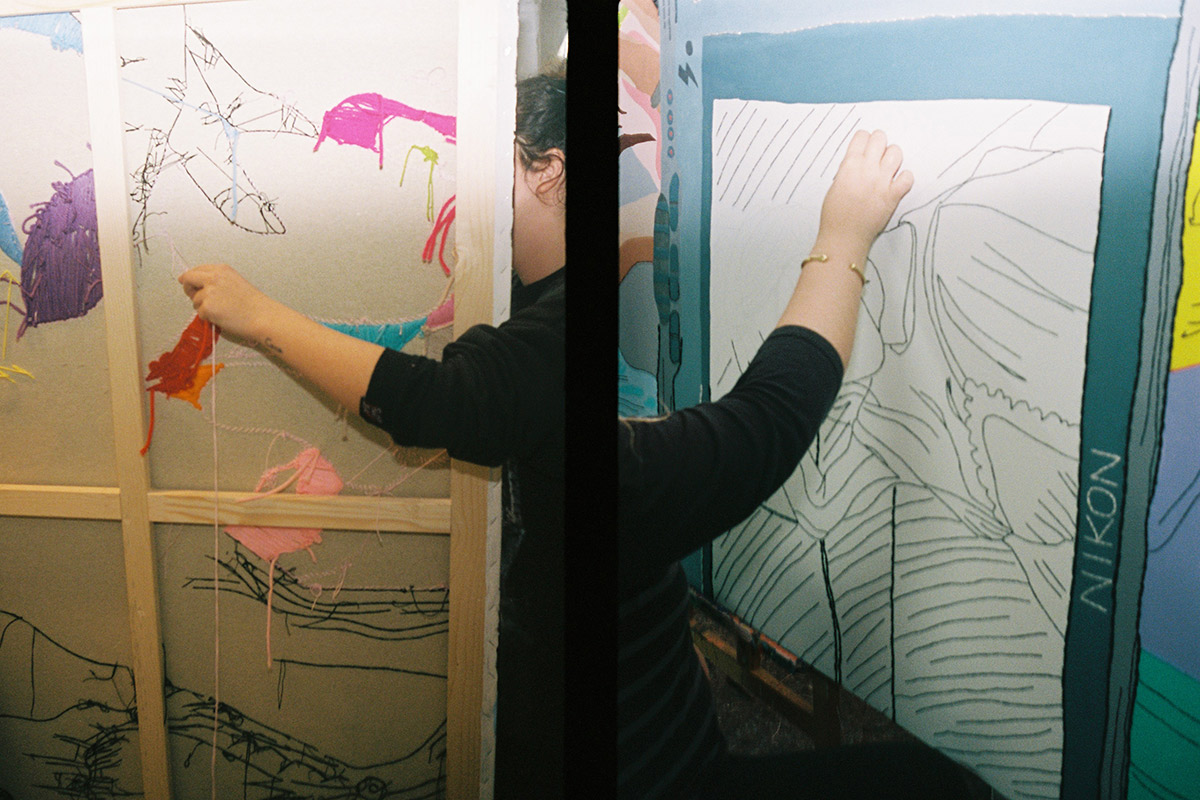
Already in Madrid, with the scholarship and studying at the university, I realised it wouldn’t be easy either. My language was very different, and I wasn’t creating functional design; my proposals were more artistic and sculptural. There was also a lot of textile research and manipulation. The years passed, and I presented at the Mercedes Benz Fashion Week in the Ego section, where I received an award. The following year, I participated in the Festival d’Hyères, where I ended up as a finalist. I returned to my island for personal reasons, but I’m not sure if it was destiny or if events unfolded this way, but I ended up in a gallery in Palma where I exhibited my collections and presented a sheet.
The gallery owner suggested I paint instead of working at the hotel, so I started painting. Six years later, I question if it’s my true path and who I am and what my intention is. It’s always personal and intimate. I try to extract concepts from personal experiences, but in the end, I don’t know why the focus shifts to me, my experiences, and my traumas. I don’t know if I’ll continue to paint, but over the past few months, I’ve been wondering what I am and what my true path is, whether it’s painting or textiles. Maybe it’s both.
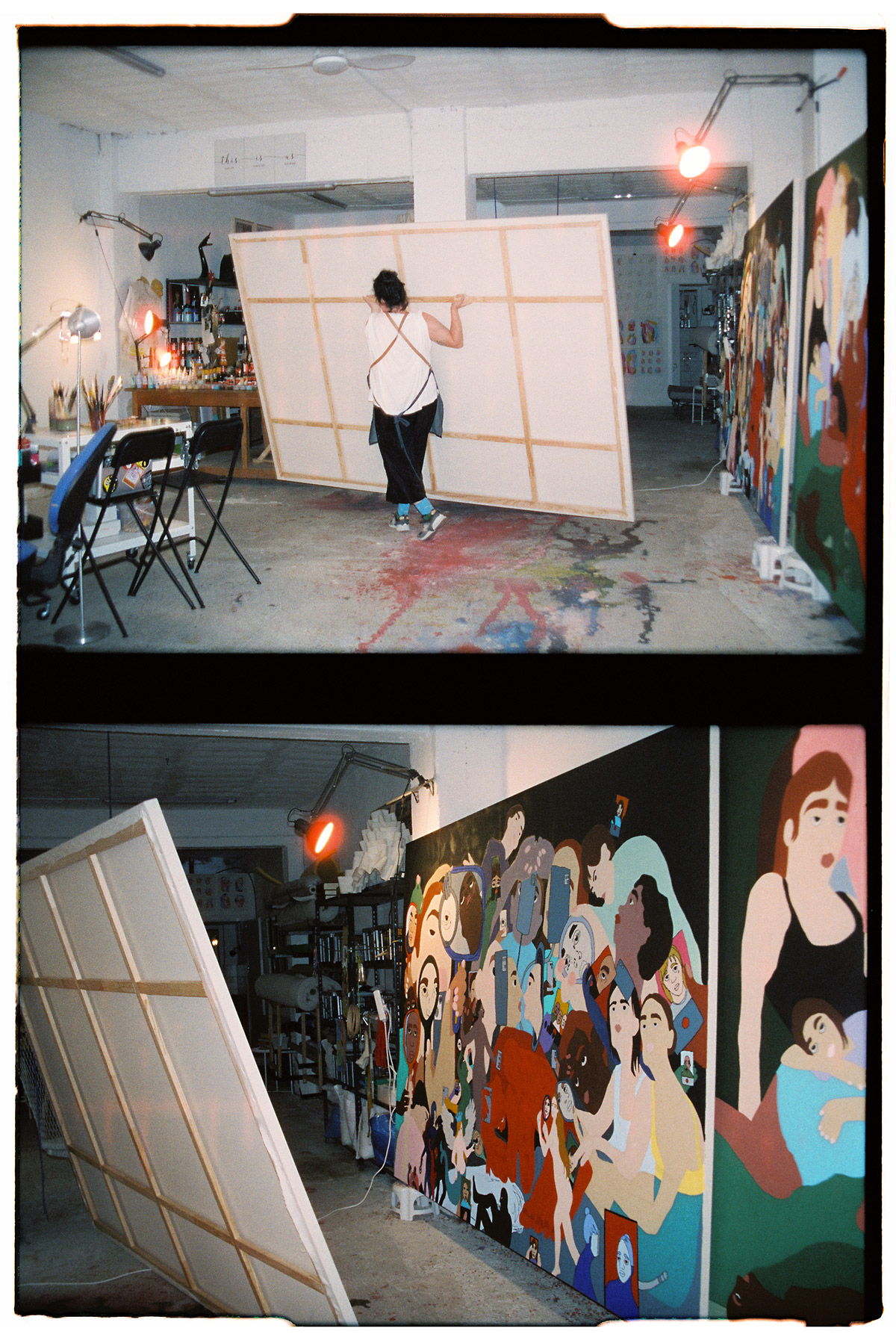
My current canvas is blank. I see figures protruding from the margins of the canvas, perhaps an allegory of myself trying to escape a format and expectations. Now, after six years of continuous and non-stop production, I feel a strong desire to lock myself in my studio, to create for the sake of experimentation, learning, and discovering new versions of myself. I want to take a break, to create not for display or teaching. I’m in a moment of introspection and contemplation.
I’ve observed that within the studio is where my true self emerges, and the idea of generating something more connected to human craftsmanship and then transferring it to “exhibition spaces” to redefine new languages to express myself also interests me. As a close friend once said, “Carta Blanca” (Blank Canvas) is the title of my current work, revealing a stage of uncertainty. Will there be painting? I don’t know… What I do know is that I want to work with textiles, focusing on the material, and let it guide me. So, for now, painting will take a back seat.
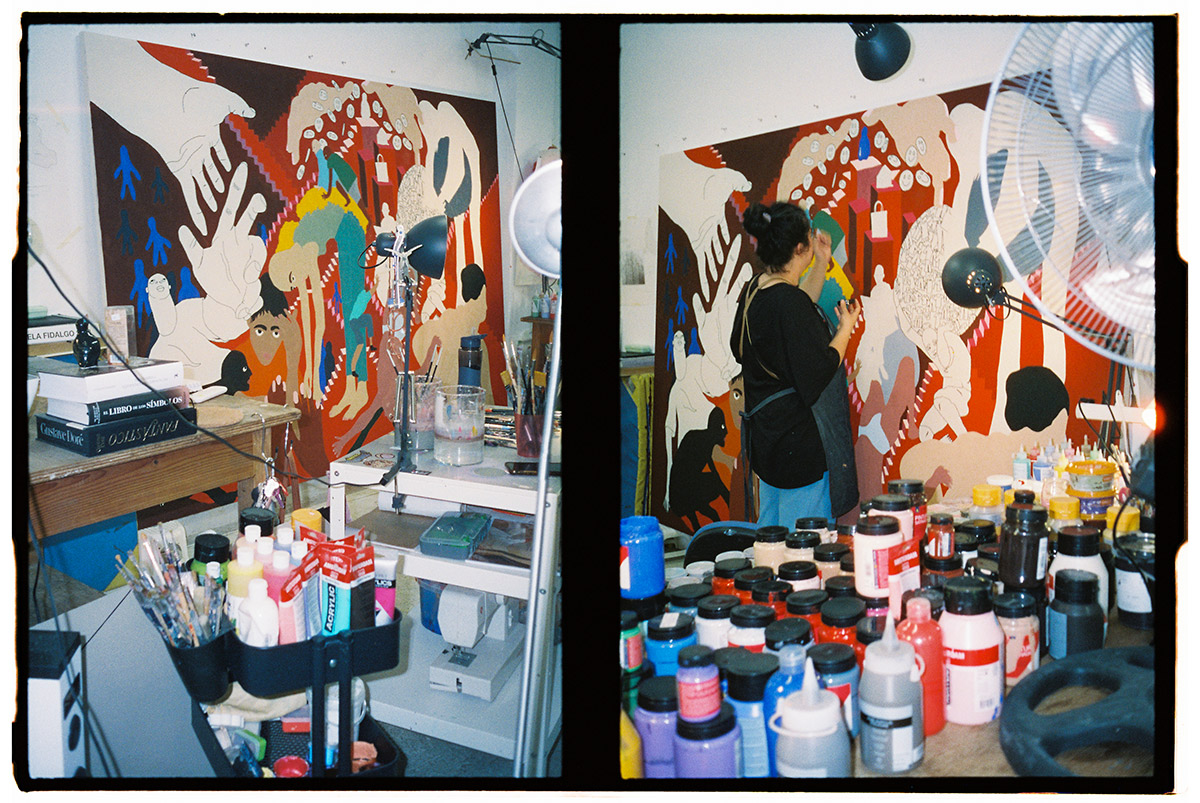
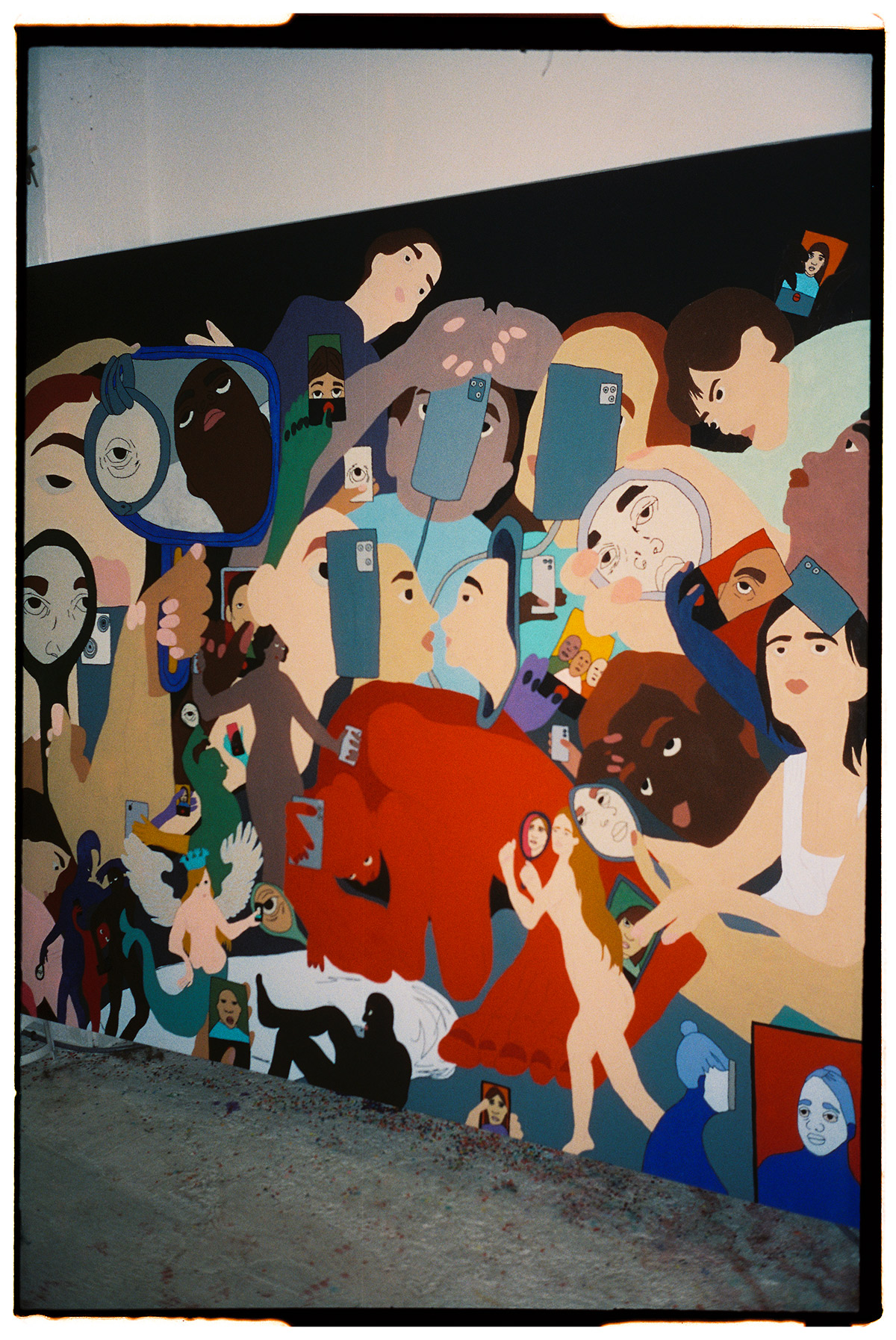
I consider myself a rather romantic person. As far as I’m concerned, the magic and truth happen in the process. Finished works, framed and hanging in a room, seem to me like corpses; as if we were at a funeral, they need to come back to life. And they come to life when they are observed, understood, and felt, transmuting into something that no longer belongs to the artist but to the person who views them. My idea is that the artist must let go of their work for others to work on and use.
The process is everything; it’s where the wonders occur. In my case, ideas usually come to me during the process, during the transformation of the research, the next ideas I want to work on and explore tend to emerge. At this moment, it’s the first time I’ll stop, and I won’t come with predetermined ideas from past projects. On the one hand, it’s terrifying, but on the other, there’s relief and tranquility. Yet, amid this uncertainty, there is also beauty.
I have a feeling that the current times, a rather complex social moment, have us caught in a wheel of dependency, consumerism, and overproduction. Everything is immediate; everything is now. A false freedom possesses us, and the process is what humanises all work; it’s the real story of the questions and answers we need as individuals. With artificial intelligence, completed works, the end of an idea, is immediate and bypasses the process. That’s why I firmly believe that the future lies with those who value the process, time, without haste, without limits, and without expectations of a final result because a machine cannot do that. We are perfectly imperfect beings.
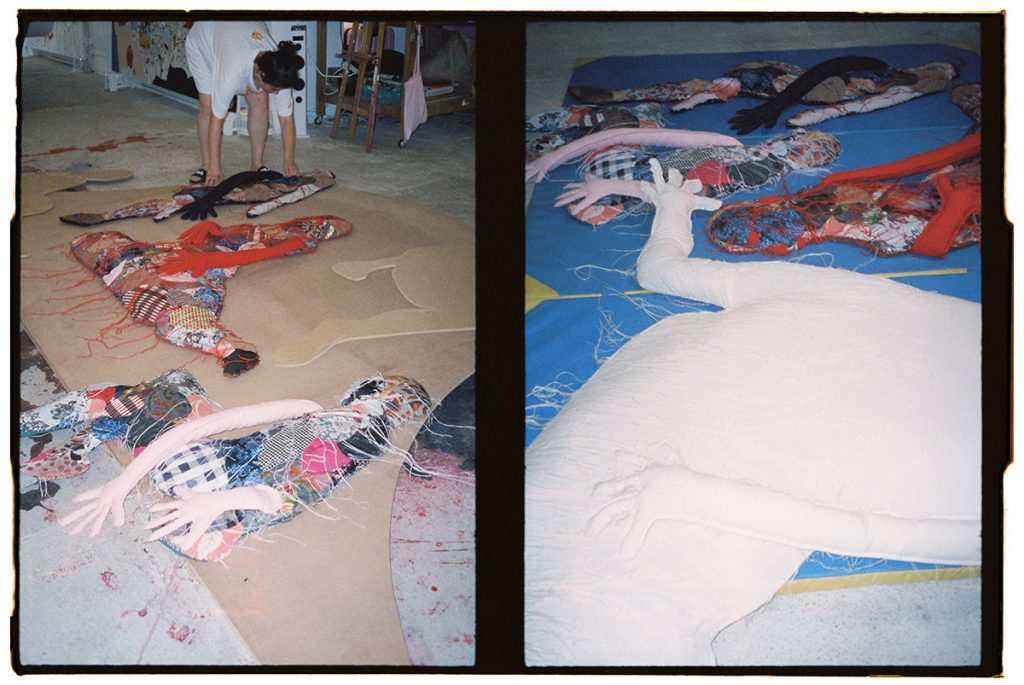
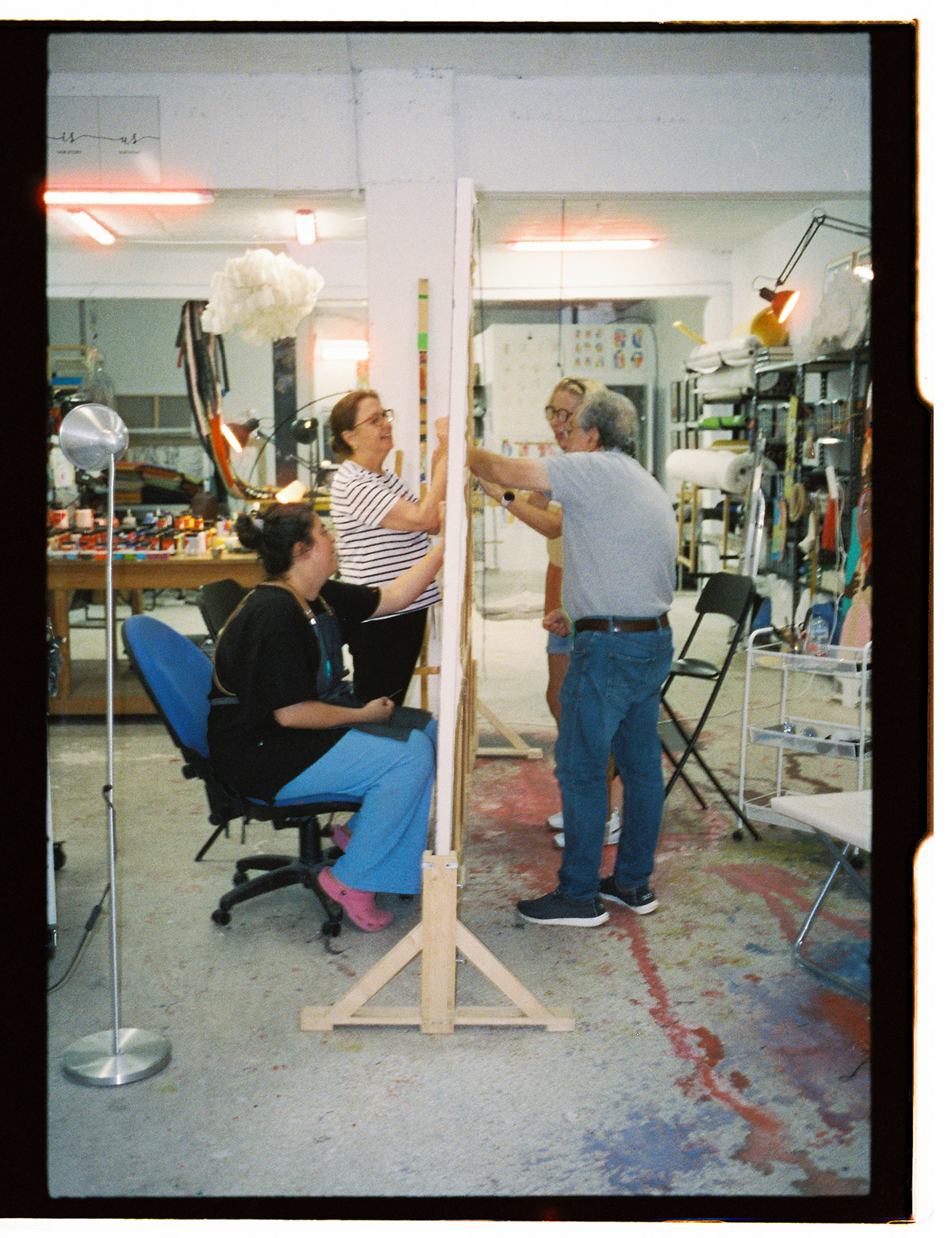
For the time being, I feel the need to express myself through figuration because I always have questions about human behaviour, our wounds, and our social burdens, etc. Since I never went to fine arts, and during artistic high school, I wasn’t very attentive in class, I’ve always had this complex of not knowing how to paint with clear shadows and realism in volumes or parts of the body. I began sewing my paintings because it was the only way I knew to convey certain textures and dimension to the work. Initially, I sewed the outlines, which, from an outside perspective, were quite metaphorical. Inside my work, those outlines serve as annotations and censorship of our own bodies and what they represent. Then, I started introducing patches of fabric to recreate shadows, as if they were patches, wounds, and traumas we want to hide out of fear of judgment or non-acceptance.
Different types of stitching like the ones I normally use for my sculptu- res also appeared, as if we were su- turing scars to close wounds. There are also tulle fabrics to recreate those transparencies, those layers that to- gether make us complete and com- plex individuals. Indeed, these three methods are quite prominent in the artistic process, albeit not necessarily in this exact order. To begin with, I initiate a rough draft that encompas- ses interesting readings, underlined passages, analysis, and reflections. I jot down questions and prefer crea- ting outlines or lists to organise my thoughts. This preliminary draft also features sketches of various body parts, faces, expressions, and pos- tures. It serves as a visual diary that includes personal observations and photographs taken on the street, ins- piring me to recreate and draw those images.
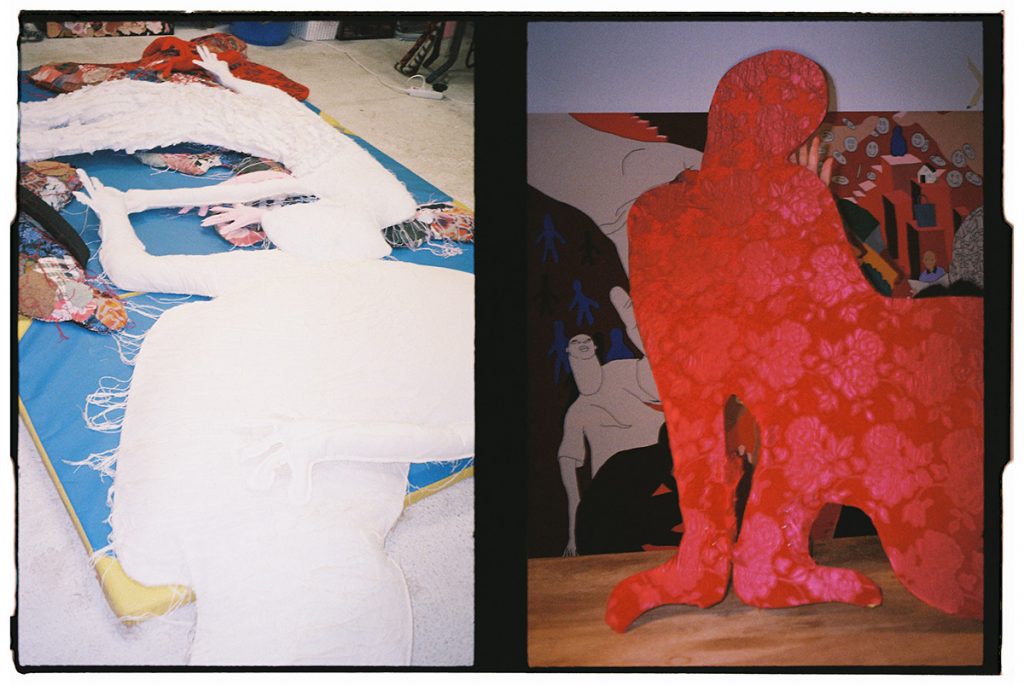
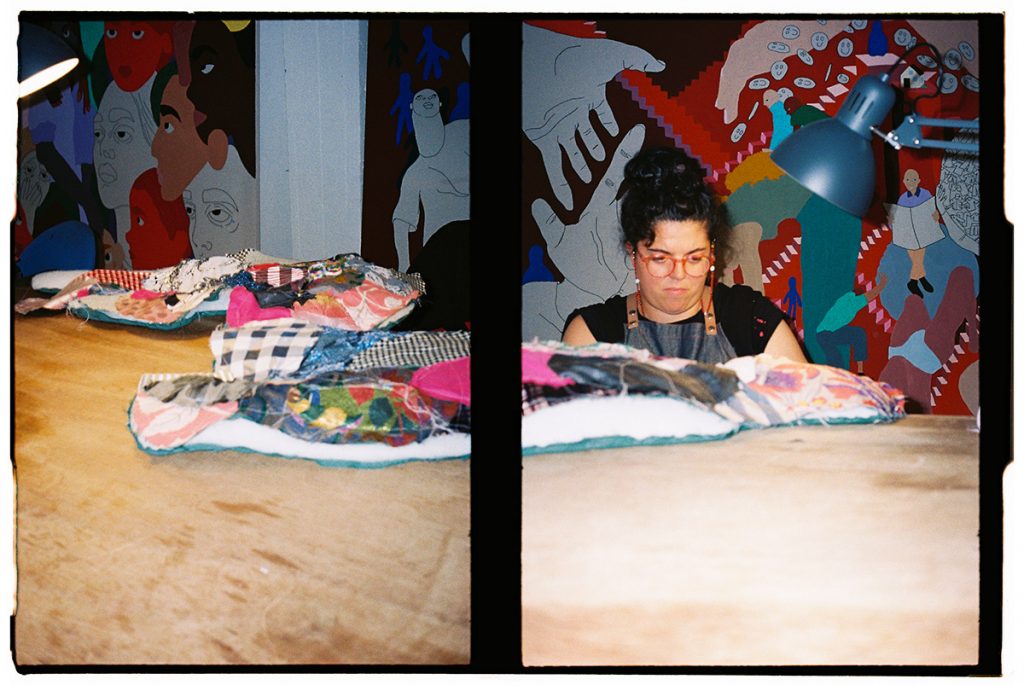
Once the concept becomes clear, and I’ve absorbed all the information, I proceed to create sketches and schematics, which will later be transferred onto canvases. When the sketch dimensions are transposed onto the canvas, there’s often room for improvisation as we commence drawing on the canvas itself. It’s during this improvisational phase that we converse with our intuition. Being an artist is a lifelong commitment. Everything I create is an extension of who I am, and I cannot imagine doing anything else. While I may have the capacity for other pursuits, this is what I have discovered I excel at. However, it is also why I’ve decided to take a pause in 2024, to stop and reflect on what I want to say and how I wish to convey it. As someone who has been surrounded by questions since childhood, many of which remain unanswered, my way of responding is through my hands. Thus far, I have painted, embroidered, and worked with textiles. Now, I’m at a point where I want to explore further, to discover new forms of self- expression within me, new formats, and tools.
I am incredibly fortunate to live and work in Mallorca, an island in the Mediterranean Sea, known for its breathtaking natural beauty and inspiring light. Living here brings me serenity, tranquility, and balance, which align well with my somewhat introverted and contemplative nature. However, the isolation can also be challenging. The island faces issues with mass tourism, limited services, and rising housing costs, which can be frustrating for residents who must grapple with these significant problems. I do appreciate the convenience of my current gallery, “La Bibi,” also based in Mallorca. It’s easy to meet with my gallerist for coffee or lunch, and we often have conversations that inspire my work. We are lucky to be close to the Tramuntana, where I can take long walks or swim in some of the island’s marvellous coves.
My studio is located in Palma, in a neighbourhood filled with local businesses and families, which I moved to because of the spacious and open area. It has been beautifully renovated, and I particularly love the worktables and shelves where I display gifts, mementos, and keepsakes. Another advantage of this location was the proximity of the workshop where I work with frames and canvases. The workshop is on the same street, and the staff there has been incredibly supportive, offering both technical assistance and psychological support. I cherish my neighbourhood, and my neighbours are friendly and supportive. Sometimes they sit and chat with me, as I often leave the doors open for passersby to see how I work.
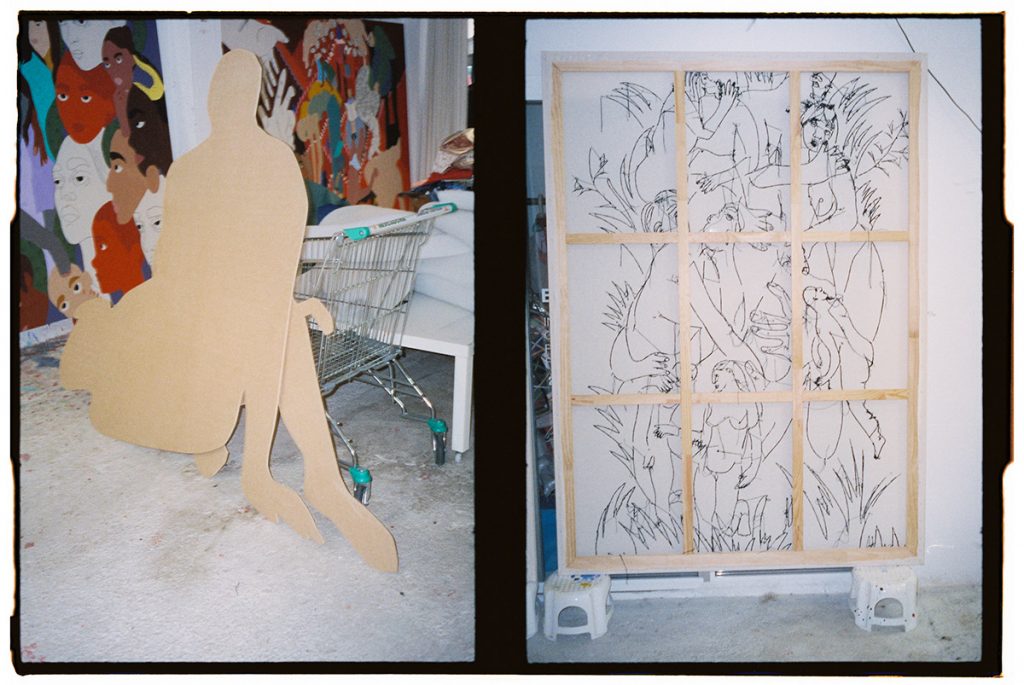
According to Marc Chagall, “Art is an arrangement of the soul.” For Picasso, it’s “a lie that makes us realise the truth.” These concepts are elusive, uncertain, and utopian. For me, art is the soul’s heartbeat made visible. It represents the purest and most authentic expression of our emotions, thoughts, and experiences. It is a universal language that transcends cultural, linguistic, and temporal boundaries. Art serves as the bridge that connects us at a deep and meaningful level. Art is the manifestation of our innate creativity, a blank canvas where we can imprint our dreams, hopes, and deepest fears. It is a medium through which we explore and discover our true selves, without restrictions or judgments. Art reflects our identity and individuality. It allows us to escape the mundane and immerse ourselves in a world of boundless possibilities. Art invites us to dream, to imagine, to question, and to challenge the status quo.
Art is a form of communication, a silent dialogue between the artist and the viewer. It enables us to share our most intimate experiences and connect with others on a profound level. It encourages us to reflect, question, and challenge our own beliefs and prejudices. Art is intimacy, a source of inspiration, and personal enrichment. It challenges us, prompts us to question, and is like Pandora’s box. Art calls us to be courageous, to be authentic, and to embrace our individuality.
